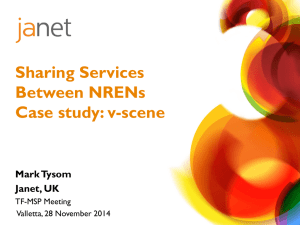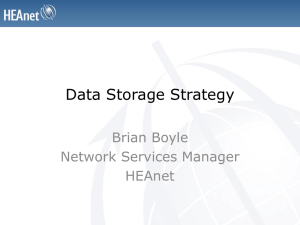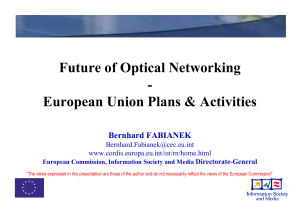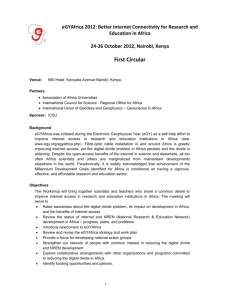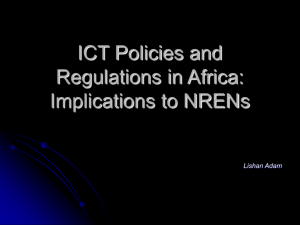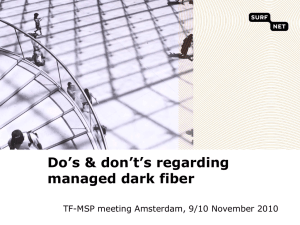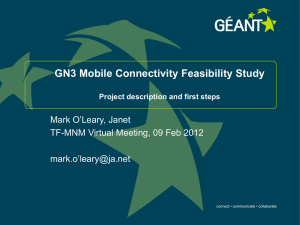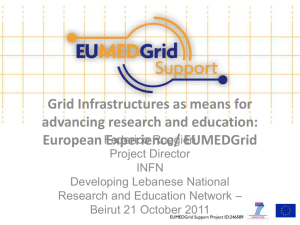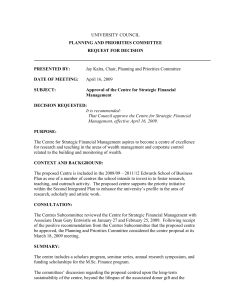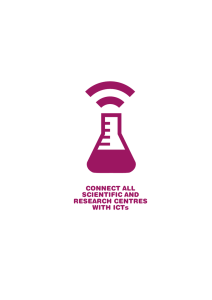Target.3: .Connect.scientific.and.research. centres.with.ICTs .
advertisement
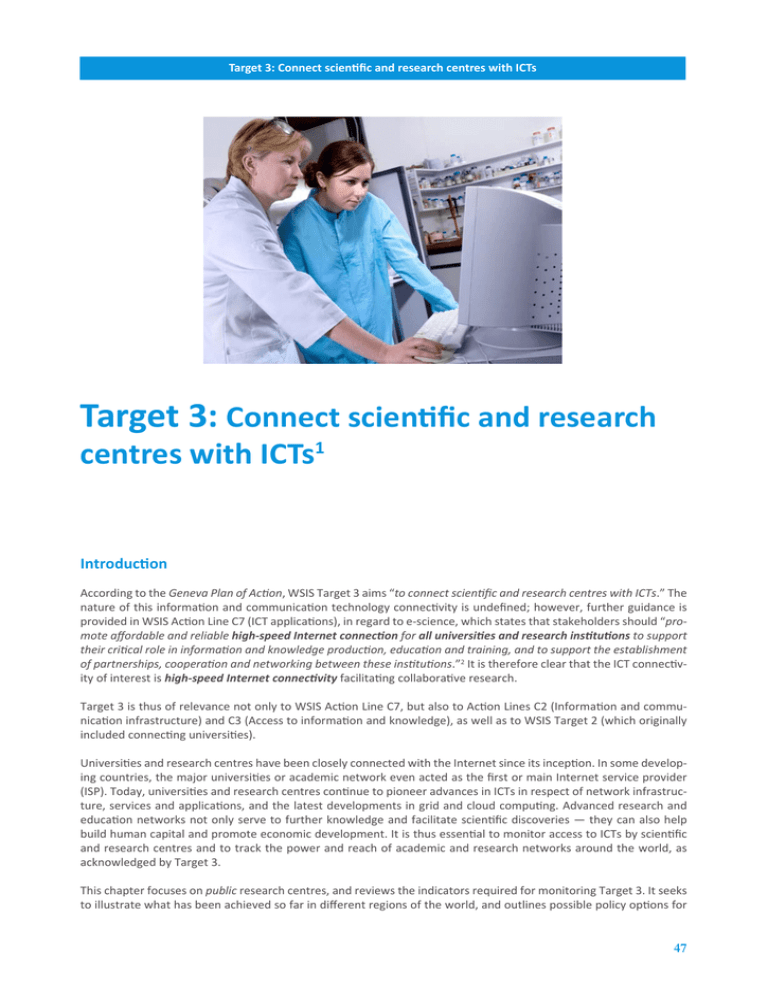
Target 3: Connect scientific and research centres with ICTs Target 3: Connect scientific and research centres with ICTs1 Introduction According to the Geneva Plan of Action, WSIS Target 3 aims “to connect scientific and research centres with ICTs.” The nature of this information and communication technology connectivity is undefined; however, further guidance is provided in WSIS Action Line C7 (ICT applications), in regard to e-science, which states that stakeholders should “promote affordable and reliable high-speed Internet connection for all universities and research institutions to support their critical role in information and knowledge production, education and training, and to support the establishment of partnerships, cooperation and networking between these institutions.”2 It is therefore clear that the ICT connectivity of interest is high-speed Internet connectivity facilitating collaborative research. Target 3 is thus of relevance not only to WSIS Action Line C7, but also to Action Lines C2 (Information and communication infrastructure) and C3 (Access to information and knowledge), as well as to WSIS Target 2 (which originally included connecting universities). Universities and research centres have been closely connected with the Internet since its inception. In some developing countries, the major universities or academic network even acted as the first or main Internet service provider (ISP). Today, universities and research centres continue to pioneer advances in ICTs in respect of network infrastructure, services and applications, and the latest developments in grid and cloud computing. Advanced research and education networks not only serve to further knowledge and facilitate scientific discoveries — they can also help build human capital and promote economic development. It is thus essential to monitor access to ICTs by scientific and research centres and to track the power and reach of academic and research networks around the world, as acknowledged by Target 3. This chapter focuses on public research centres, and reviews the indicators required for monitoring Target 3. It seeks to illustrate what has been achieved so far in different regions of the world, and outlines possible policy options for 47 WTDR 2010: Monitoring the WSIS targets achieving the target by 2015, in order to give policy-makers some ideas for formulating policies that take account of the speed, quality and reliability of telecommunication infrastructure for scientific research purposes. Scientific and research centres Scientific research is constantly evolving, matched by advances in data analysis and networking technologies. For example, particle physics has only existed as a separate discipline for the last century, and modern bioengineering for a mere two decades, but the data-computing requirements of advanced bioengineering are set to outstrip those of particle physics during the next three years, at current growth rates. Advances in computing power and ICTs are shaping modern science, and driving new forms of collaborative research and networking between institutions. It is important to identify the set of scientific and research institutions within a country. Scientific and technical research has been defined by UNESCO.3 Further UNESCO definitions delimit fundamental research (pure and oriented) and applied research and development (R&D).4 Modern definitions of research frequently distinguish research according to the agents and funding (public or private) involved, which may often influence the knowledge outcomes. The definition of tertiary education institutes (including universities) is provided by UNESCO’s International Standard Classification of Education (ISCED).5 Most universities should be included in the set of scientific and research centres for Target 3, but not all — not all universities offer science degrees, and not all universities conduct research. These UNESCO definitions are important, as they determine the overall set of scientific and research centres to be connected with ICTs under Target 3. This set of research institutions is likely to be known to the national government, and may have been endorsed by UNESCO. Having said that, the categorization of a research institution does not necessarily give an idea of its role in education or research, the nature of its research or the extent of collaboration with other institutions. It is also essential to define the nature of the ICT connectivity. For some research institutions, basic connectivity to the Internet and online access to scientific journals may be sufficient for many of their research needs. WSIS Action Line C7, in particular § 22 thereof on e-science, prescribes that the ICT access should comprise an affordable and reliable high-speed Internet connection. However, the WSIS outcome documents do not specify what the Internet connectivity should be used for, other than “information and knowledge production, education and training, and to support the establishment of partnerships, cooperation and networking.” In addition to simply ensuring access to the Internet, “connecting research centres” could also be interpreted as meaning establishing links and networks between them. For modern scientific and research purposes, the existence of a national research and education network (NREN) is one indicator of the use of ICTs by the research and education community, and thus, by inference, constitutes an indicator of a country’s ability to participate in international research (see Box 3.1 — What is an NREN?). As scientific research continues to evolve, connection to and participation in an NREN will become increasingly important. Europe’s Delivery of Advanced Network Technology to Europe (DANTE)6 notes that NRENs perform two main functions in relation to scientific research: • NRENs act as high-capacity ICT infrastructures to support the work of researchers, promote collaboration, transfer data and share information or confirm experiments; • NRENs can also facilitate new research in their own right, by providing platforms and experimental test-beds for testing new services and advanced networking technologies. A list of 120 known NRENs is presented in Annex 3.1, revealing substantial regional disparities (Chart 3.1). There are a total of 14 NRENs located in Africa, 20 in the Americas, 25 in Asia and the Pacific, 12 in the Commonwealth of Independent States (CIS) and 38 in Europe. The CIS is notable for being the only region where all countries have established NRENs. The technologies used by an NREN are an important factor, as not all types of connectivity are equal, and fibre-based networks are likely to be more “future-proof” than some other types of technology. 48 Target 3: Connect scientific and research centres with ICTs Box 3.1: What is a national research and education network (NREN)? A national research and education network (NREN) is a specialized Internet service provider dedicated to supporting the needs of the research and education communities within a country. It usually administers and supports a high-speed backbone network, often offering dedicated channels for individual research projects. The term “NREN” was originally a service mark of the U.S. government, registered with the U.S. Patent and Trademark Office. However, since then, the term has come to be applied to refer to national research and education networks more widely and, by inference, their regional and international connectivity. NREN in the United States had four original purposes, some of which are mirrored in other countries: • • • • To encourage widespread use of high-capacity networks by the research and education communities to access highperformance computing systems and research facilities To develop advanced high-performance networking technologies and accelerate their deployment and evaluation in research and education environments To stimulate the widespread availability at reasonable cost of advanced network products and services from the private sector for the general research and education communities To catalyse the rapid deployment of a high-speed general-purpose digital communications infrastructure for the nation. Another example is India’s three educational networks — the Education and Research Network (ERNET), BIOGRID (a VPN of the Department of Biotechnology, Government of India) and GARUDA (grid computing initiative). Each serves its respective client bases — ERNET is the exclusive provider of international connectivity to all higher-education institutes. All the networks deliver network connectivity (including Internet access) to universities, technology institutes and various government agencies on a national basis. Private-sector operators provide further international connectivity via cable and satellite for personal and commercial consumption. Several points emerge from these examples. Firstly, the network administrator often acts as an ISP and is closely identified with the network it oversees. Secondly, such NRENs usually offer a mix of dedicated channels and public Internet access, often through a combination of dedicated backbones, leased lines or private-sector operators. Thirdly, such networks connect a range of different institutions, often with different needs. In order to provide services to diverse clients, high capacity is often important. Source: NREN definition from http://www.nitrd.gov/pubs/implementation/1995/section.4.3.html and http://en.wikipedia.org/wiki/National_research_and_education_network. “High Performance Computing Networks for Research, Education, Science and Technology in India,” available at: http://garudaindia.in/pdf/papers_presentations/India-High%20Performance%20Computing%20Networks%20 &%20NRENS.pdf. Chart 3.1: Countries with a national research and education network (NREN), by region, 2010 NREN % 100 No NREN present 80 100% 88% 60 64% 62% 40 57% 52% 20 33% a ric Af at es St as Ar ab Am er ic W or ld ci fic As ia an d th e Pa ro pe Eu C IS 0 Source: ITU (see also Annex 3.1). 49 WTDR 2010: Monitoring the WSIS targets Measuring Target 3 — Proposed indicators For the purposes of measuring Target 3, the focus is on public research centres; privately-owned or privately-funded infrastructures used for scientific research are not considered, since they are proprietary and may be difficult to measure (this is consistent with DANTE’s definition of research networking as the provision of data communications for the use of the research and academic community).7 Nor is the target concerned with day-to-day operational network performance indicators. The following indicators are proposed to monitor this target: 1. Percentage of public scientific and research centres8 with access to the Internet, by type of access 2. Presence of a national research and education network (NREN), by bandwidth (Mbit/s) 3. Number of national research and education network (NREN) nodes 4. Percentage of universities connected to the national research and education network (NREN), by type of connection (narrowband, broadband) 5. Percentage of public scientific and research centres connected to the national research and education network (NREN), by type of connection (narrowband, broadband). The main emphasis of Target 3 is on “ICT connectivity.” However, connectivity alone does not provide any information as to what the Internet access is likely to be used for — basic Internet connections may be utilized for e-mail only, and not collaborative research or data processing which can sometimes require vast capacity. In fact, depending on the speed, even a broadband Internet connection may still be insufficient for advanced research, data transfer and processing. The scale and connectivity of NRENs differ greatly. The number of NREN nodes in a country depicts the size of the NREN, but such nodes are usually not all scientific and research centres and often include other institutes, such as schools, museums, libraries, hospitals or government departments. The Trans-European Research and Education Networking Association (TERENA) collects data on various aspects of NRENs, mainly in European countries but also for some other networks (see Box 3.2, and Annex 3.2 for an extract of their questionnaire). Classification of NRENs and the collection of data on NRENs and NREN bandwidth come up against several measurement challenges, however. Firstly, it is not always clear how “sovereignty” can be attributed to an international network. For example, the European Organization for Nuclear Research (CERN) is an international organization comprising twenty countries, and it is not possible to ascribe its bandwidth to Switzerland or France as its host territories. There may also be a risk of double-counting of bandwidth for trans-border links — i.e. both countries may report the bandwidth of a single link, which may thus end up being counted twice. The main focus for many NREN managers is on collecting information on network performance, including performance of the NREN and its connectivity to other NRENs through the backbone. Indeed, beyond initial installation and expansion, their concern will be monitoring the real-time status of the network in terms of traffic volumes, reliability, security and quality of service (QoS). Network performance indicators include link usage data (e.g. average traffic volumes per day, month, year); achieved data rates; latency and jitter statistics (e.g. one-way delay, delay variation); packet-loss rates; number of outages and/or breaches; and security concerns (e.g. the number of people authorized to access the network at any point in time). Methods used for collecting and analysing performance data vary between research and education network domains,9 from simple data on levels of link usage and traffic-volume statistics to detailed protocol analysis.10 However, such detailed performance data are unlikely to prove relevant for the purposes of monitoring the growth in capacity of international scientific and research networks. 50 Target 3: Connect scientific and research centres with ICTs Box 3.2: Data collected by the Trans-European Research and Education Networking Association (TERENA) The TERENA Compendium — TERENA’s main reference document — defines a point of presence (PoP) as a point on the NREN backbone which can connect client networks or aggregations of client networks or external networks [TERENA, 2009]. Institutions can be connected through a direct PoP on the NREN backbone, or through a metropolitan access network (MAN) or radio access network (RAN), or, alternatively, served through a connected site. The TERENA Compendium asks for: • the total number of PoPs on the NREN; • the number of places for core networking routing; • the number of managed sites (where routing or switching equipment is managed); and • the number of circuits carrying production traffic. In addition, TERENA also poses questions relating to the availability of optical PoPs and total length of dark fibre in kilometers, replacing a previous question asking for an estimate of bandwidth multiplied by distance, which NRENs found increasingly difficult to answer. TERENA asks for the typical core usable backbone capacity of the NREN, although questions on capacity distinguish between usable capacity, maximum capacity (excluding back-up routes) and total capacity (for different point-topoint IP links). The total capacity of the network does not apply to each institution that connects to it, and this distinction is made clear by these definitions. The TERENA Compendium distinguishes between lower, upper and typical access speeds to different types of institutions, in implicit recognition of their different needs. These indicators reveal the potential capacity of an NREN, the traffic volumes and transmission speeds of any research network, and its actual connectivity. They also enable growth in the extent, speed and capacity of networks to be monitored over time. Status of the target ITU conducted an ad-hoc survey in 2009 in the context of monitoring the WSIS targets. This survey included questions on Internet access in research centres (Table 3.1) and on NRENs (Table 3.2). Every country for which data are available reported that scientific and research centres have Internet access, almost always with a broadband connection (Table 3.1). The number of reported scientific and research centres varies greatly across countries, but this might reflect differences in definitions, not to mention differences in country size, population, development and education levels. Several countries also reported information on the presence of an NREN. An NREN exists in the majority of reporting countries, but the bandwidth of the network varies greatly, from 1.55 Mbit/s and 2 Mbit/s in Mexico and Albania, respectively, to 40 000 Mbit/s in the United Kingdom (Table 3.2). The survey did not include questions on whether the NREN was linked to other countries or other regional networks, but this information would be useful to collect in the future. The number of nodes and countries covered are common indicators reported by any international collaborative research network — for example, APAN covers 16 countries, TEIN2 covers 10 Asian countries, GÉANT2 and LHCG cover 34 countries, CLARA covers 15 countries, EUMEDCONNECT2 covers seven and NORDUNet five. According to DANTE, the speed of the fastest links in pan-European networks has increased by a factor of 5 000 over the last decade, while the number of European countries connected has more than doubled over the same period.11 51 WTDR 2010: Monitoring the WSIS targets Table 3.1: Public scientific and research centres with access to the Internet, 2009* Country Albania Andorra Bhutan Bolivia Bosnia and Herzegovina Botswana Brunei Bulgaria Croatia Denmark Djibouti Egypt Hungary Korea (Rep.) Latvia Lithuania Morocco Myanmar Nauru Netherlands New Zealand Paraguay Singapore United Kingdom Number of public Number of public % of public scienscientific and scientific and tific and research research centres research centres centres with with Internet ac- Internet access cess (any type of (any type of conconnection) nection) 50 50 100 2 2 100 5 5 100 148 ... ... 16 16 100 3 3 100 0 0 ... 139 139 100 51 51 100 73 73 100 1 1 100 455 455 100 57 57 100 27 27 100 126 126 100 111 ... ... 22 22 100 ... 40 ... 0 0 ... 100 100 100 16 ... ... 4 ... ... 21 21 100 153 ... ... Number of public % of public scienscientific and tific and research research centres centres with with Internet ac- Internet access cess (broadband (broadband conconnection only) nection only) 48 96 2 100 ... 100 ... ... 16 100 3 100 0 ... 139 100 51 100 73 100 1 100 455 100 57 100 27 100 126 100 ... ... 22 100 ... ... 0 ... 100 100 ... ... ... ... 21 100 ... ... Note: *Or latest year available. “...”: data not available. Source: ITU Survey on the WSIS Targets. TERENA also collects data on connection policy, e.g. which institutions are formally permitted to connect to the NREN, and the extent to which connection is achieved (Table 3.3). All NRENs allow universities, research institutes and, with four exceptions, higher-education institutes to connect to the network. For other institutions, there are significant differences in policy between NRENs. For example, some NRENs may only connect government departments that are directly related to research and education [TERENA, 2008]. In many countries, all universities are connected to the NREN, although in some countries the proportion of universities connected to the NREN may be much lower, even 50 per cent or less, e.g. Georgia (50 per cent), Belarus (35 per cent), Israel (25 per cent), Ukraine (22 per cent), Macedonia (20 per cent) and the Czech Republic (7 per cent). The proportion of research institutes connected to the NREN tends to be lower than the proportion of universities connected to the NREN, except in Georgia, Macedonia, Moldova and Ukraine. The bandwidth of NRENs12 in EU and EFTA countries grew significantly between 2001 and 2008, and further increases are expected in the near future (Table 3.4). For the EU/EFTA countries, the average bandwidth doubled over the period. 52 Target 3: Connect scientific and research centres with ICTs Table 3.2: NRENs, 2009* Country Does your country have a national educational and research network? Name of the . network Website of the network Bandwidth of the network (Mbit/s) Albania Yes Albanian Academy Network Under construction 2 Andorra No - - - Bhutan No - - - Bolivia No - - - Bosnia and Herzegovina No - - - Botswana No - - - Brazil Yes Rede Nacional de Esino e Pesquisa www.rnp.br ... Brunei Darussalam No - - - Bulgaria Yes Bulgarian Network and Research Network (NREN-BG) www.nren-bg.eu 1 000 Croatia Yes Croatian Academic and Research Network — ­ CARNet www.carnet.hr 10 000 Czech Republic Yes CESNET 2 www.cesnet.cz 10 000 Denmark Yes Forskningsnettet www.forskningsnettet.dk ... Egypt Yes Egyptian universities network (EUN) www.eun.org 310 Finland Yes Funet www.csc.fi/english/institutions/funet/index_html ... Haiti No - - - Hungary Yes NIIF/Hungarnet www.niif.hu 10 000 Korea (Rep.) Yes KOREN, KREONET www.koren.kr, www.kreonet.re.kr ... Latvia Yes SigmaNet www.sigmanet.lv 2 500 Lithuania Yes LITNET, Academic and Research Network in Lithuania www.litnet.lt ... Mexico Yes CUDI www.cudi.edu.mx 1.55 Morocco Yes MARWAN www.marwan.ma 100 Nauru No - - - Yes Research and Education Advanced Network New Zealand Ltd (REANNZ) http://reannz.co.nz/home/ 10 000 Singapore Yes Singapore Advanced Research and Education Network SingAREN www.singaren.net.sg 10 200 Slovak Republic Yes SANET — Slovak Academic Network http://www.sanet.sk ... Slovenia Yes ARNES www.arnes.si ... Sweden Yes SUNET http://basun.sunet.se ... ... New Zealand Thailand Yes UNINET and ThaiREN www.uni.net.th/UniNet/Eng/index_eng.php www.thairen.net.th/NewThaiRen/Thai/index_th.php# Turkey Yes ULAKBIM http://www.ulakbim.gov.tr/eng/ulaknet 3 000 United Kingdom Yes JANET www.ja.net/company/about.html 40 000 Note: *Or latest year available. “...”: data not available. Source: ITU Survey on the WSIS Targets. 53 WTDR 2010: Monitoring the WSIS targets The growth in average bandwidth masks significant differences, however. For some NRENs, bandwidth remained roughly the same, whereas for others (e.g. CyNet and ARNES), it increased a hundredfold or more. The highest average NREN bandwidth capacities in Europe in 2008 were 20 Gbit/s, as against 10 Gbit/s in 2006. In comparison, CANARIE of Canada had a bandwidth capacity of 50 Gbit/s in 2007. The evolution of bandwidth capacity in the “Other” countries in Table 3.4 reflects the effect of the introduction of affordable Gigabit ethernet technology, which is now used by many countries. In most countries, bandwidth capacity will evolve to multiples of 10 Gbit/s. Furthermore, even though many EU/EFTA countries already have high capacities, they foresee further upgrades in the next two years. Many other countries also expect to upgrade to Gigabit capacities. TERENA also notes a clear trend in the bandwidth of universities [TERENA, 2008]. In 2003, the “average” university was connected to the NREN at Megabit capacity; by 2008, that had increased to Gigabit capacity. TERENA’s data show a clear growth in total core capacity for NRENs in 44 countries over the period 2001-2008 (Chart 3.2, left). Over the same period, the number of countries with NRENs with capacity of 10 Gbit/s or more also grew considerably (Chart 3.2, right). The trend is less pronounced in the countries outside the EU/EFTA area. Furthermore, the increases tend to occur in steps, as new technologies are introduced. However, the organizational set-up of universities and other institutes may vary significantly across countries, which can have an effect on university bandwidth requirements. For example, research institutes may be part of universities, but not in all countries. There may also be substantial differences among countries in terms of the number and/or size of universities. A university may have a single link to the NREN, or multiple links, for example, to faculties or schools that form part of it, but are geographically at different locations. In terms of total access capacity, in the EU/EFTA countries for which data are available, more than 80 per cent of the access bandwidth capacity on average (weighted) is used for the tertiary education sector. In addition to connecting universities and research centres to NRENs, it is also important to connect NRENs to each other, for example through regional networks. The Observatory for the Information Society in Latin America (OSILAC) collected data on the characteristics of NRENs in Latin-American countries, including whether they were connected to the regional network RedCLARA (see Annex 3.3.) [OSILAC, 2007]. Almost all regions now enjoy positive spillovers from access to advanced research and education networks — for example, CERN’s Global Lambda Interchange Facility includes connectivity to all global regions except Africa. In some regions, NRENs are being aggregated into pan-regional networks — for example, the CARINE network being set up across the CIS countries. The extension of high-capacity connectivity to a region often prompts countries that did not previously have a research and education network to establish one — this happened, for example, in the case of the ALICE project to connect Central and Latin American research institutions to European research institutions. The growth of these networks is usually project-driven and funded on an individual project basis. Total bandwidth of NRENs, 44 countries, 2001-2008 200 000 180 000 160 000 140 000 120 000 100 000 80 000 60 000 40 000 20 000 0 2002 2004 2006 2008 Source: ITU (see also Annex 3.1). 54 14 Number of countries Mbps Chart 3.2: Selected characteristics of NRENs in Europe, 2001-2008 Number of countries with NRENs of >10 Gbps, 2001-2008 12 10 8 6 4 2 0 2002 2004 2006 2008 ACOnet BELNET CYNET CESNET UNI-C EENet Funet RENATER DFN GRNET S.A. NIIF/HUNGARNET Rhnet HEAnet GARR SigmaNet LITNET RESTENA UoM, IT Services SURFnet UNINETT PIONIER FCCN Belgium Cyprus Czech Republic Denmark Estonia Finland France Germany Greece Hungary Iceland Ireland Italy Latvia Lithuania Luxembourg Malta Netherlands Norway Poland Portugal NREN Austria EU/EFTA countries Country 95 100 100 100 100 100 100 70 100 100 100 100 100 98 100 100 82 100 7 100 95 100 Universities 90 + 90 95 50 100 85 5 100 100 90 80 100 98 + - 34 80 3 10 5 50 Institutes of higher/ further eduction 90 100 50 80 + 100 92 19 98 60 65 100 100 93 + 48.1 49 50 6 100 80 50 Research institutes 100 + 8 2 + 100 78 2.5 0.5 96 + 5 100 + + - 57 - 36 - 30 + Secondary schools 100 + 13 0.5 + 80 16 - 1 96 - 0.2 99.8 + - - 57 - 7 - 35 + - + 30 15 + 50 16 3.2 7 1 10 85 1 + + 10 11 5 9 - 5 20 - + - 1 90 11 1.8 12 - - 30 - + + - + 10 8 - 5 20 Libraries, mu- Hospitals (other Primary schools seums, national than university archives hospitals) Table 3.3: Types of institutions for which connection to the NREN is allowed (%)*, selected countries, 2008 2 + - - 3 5 + 5 2 - 1 1 + + 1 1 - 12 - 10 10 Government departments (national, regional, local) - + + + + - + + + + - + + - - + - + + + + - Others Target 3: Connect scientific and research centres with ICTs 55 56 ARNES RedIRIS SUNET SWITCH JANET(UK) RoEduNet BREN Slovenia Spain Sweden Switzerland United Kingdom Romania Bulgaria 22 95 95 70 100 70 62 20 25 50 100 35 75 100 100 100 100 100 100 100 Universities 45 - 5 2 96 - 25 + - 40 100 + 10 80 100 5 + - 98 100 34 60 40 40 50 50 80 38 3 75 100 31 90 85 100 15 + 95 80 100 Research institutes + - 2 10 + 20 + + - 30 50 + 100 75 95 5 - - 95 10 Secondary schools + - + - + 20 + + - - 50 + 6 20 100 + - - 80 5 5 1 5 4 10 20 30 34 + 1 1 14 1 70 + 10 + 3 50 10 - - 5 - + - 5 + + 0.5 0.5 2 - - - + - 35 - - Libraries, mu- Hospitals (other Primary schools seums, national than university archives hospitals) 12 1 5 1 3 10 5 10 - 0.5 0.5 1 - 25 + 10 + 5 - 10 Government departments (national, regional, local) - + - - - + + - + + - - - + + + + - - Others * Note: ++means meansititisisallowed allowedbut butthe thepercentage percentageisisnot notreported, reported,--means meansititisisnot notallowed. allowed.The Thepercentages percentagesininthe thetable tableshow showthe thepercentage percentageof ofthe thetotal totalnumber numberof ofinstitutions institutionsconnected connectedto tothe theNREN. NREN. Public institutions connected to the NREN by other ISPs are not taken into account. TERENACompendium Compendium2008, 2008,Table Table2.2.1, 2.2.1,pp pp25-26. 25-26. Source: TERENA UARNET MARWAN Morocco Ukraine MREN Montenegro ULAKBIM RENAM Moldova Turkey MARNet Macedonia AMRES IUCC Israel Serbia GRENA Georgia Federa- RBNet/RUNNet CARNet Croatia Russian tion BASNET Belarus Other countries SANET NREN Slovak Republic Country Institutes of higher/ further eduction Table 3.3: Types of institutions for which connection to the NREN is allowed (%)*, selected countries, 2008 (continued) WTDR 2010: Monitoring the WSIS targets Target 3: Connect scientific and research centres with ICTs Table 3.4: Bandwidth of NRENs, Mbit/s, 2001-2008, and expected change for 2010 Country NREN 2001 2002 2003 2004 2005 2006 2007 2008 2010 1 000 1 000 Multi 10 Gbit/s Vienna Core, 10 Gbit/s Austrian Backbone EU/EFTA countries Austria ACOnet 155 1 000 1 000 1 000 1 000 1 000 Belgium BELNET 622 1 000 4 976 4 976 4 976 10 000 10 000 10 000 Bulgaria BREN ... ... 2 100 10 155 100 100 2.5 - 10 Gbit/s Cyprus CyNet ... ... 2 34 2 2 1 000 1 000 1 Gbit/s Ethernet network Czech Republic CESNET Between 10 and 20 Gbit/s 2 488 2 488 2 500 2 488 2 488 10 000 10 000 10 000 Denmark UNI-C 622 622 622 1 000 2 488 2 488 2 000 2 000 Estonia EENet 24 60 100 100 1 000 1 000 1 000 1 000 10 Gbit/s 2 488 10 - 40 Gbit/s DWDM ring with multiple 10 G 2 488 2 488 2 488 2 488 2 500 2 500 10 G in most cases (IP service); lighpath availability to most PoPs 2 488 2 488 2 488 2 488 2 500 2 500 10 Gbit/s Finland Funet 2 488 France RENATER 2 488 ... Germany DFN 622 2 488 Greece GRNET ... 310 310 2 488 2 488 Hungary NIIF/HUNGAR NET 155 2 488 2 488 2 488 10 000 10 000 10 000 10 000 Iceland Rhnet ... 1 000 1 000 1 000 1 000 1 000 1 000 Ireland HEAnet 155 310 310 1 000 1 000 1 000 10 000 10 000 Italy GARR ... 2 488 7 500 2 488 2 488 10 000 10 000 10 000 40 Gbit/s Latvia SigmaNet 100 100 100 100 2 488 10 000 1 000 1 290 3500 Mbit Lithuania LITNET 4 155 155 155 310 310 1 000 1 000 ... Luxembourg RESTENA 10 1 000 1 000 1 000 1 000 1 000 1 000 1 000 10 Gbit/s Malta UoMallta ... ... ... 100 45 1 000 1 000 1 000 2 Gbit/s Netherlands SURFnet 2 488 10 000 10 000 10 000 10 000 10 000 20 000 20 000 40 Gbit/s Norway UNINETT 2 488 2 488 2 488 2 500 10 Gbit/s Poland PIONIER 155 155 622 10 000 10 000 10 000 20 000 20 000 40 Gbit/s Portugal FCCN 180 180 1 200 1 200 2 488 2 488 Romania RoEduNet ... ... 34 155 310 310 1 000 1 000 Slovak Rep. SANET 4 1 000 1 000 1 000 1 000 1 000 1 000 1 000 Whole backbone 10 GE or n x 10 GE Slovenia ARNES 100 100 10 310 1 000 1 000 1 000 1 000 Spain RedIRIS 155 155 2 488 2 488 2 488 2 488 10 000 10 000 Sweden SUNET 622 1 000 Switzerland SWITCH 310 ... United Kingdom JANET (UK) 2 488 2 488 10 000 10 000 10 000 10 000 10 000 10 000 2 488 2 488 2 488 2 488 2 500 2 500 2 500 1 000 10 000 10 000 10 000 10 000 10 000 10 000 10 000 10 000 1 000 1 000 10 000 10 000 10 000 10 000 10 000 10 000 10 000 10 000 10 000 10 000 Similar n x 10 Gbit/s 10 Gbit/s 10 Gbit/s n x 10 Gbit/s 40 G 10 Gbit/s 1 Gbit/s n x 10 Gbit/s Same 2 x 10 Gbit/s in parallel 40 Gbit/s Other countries Algeria CERIST ... ... 155 155 310 310 34 ... Azerbaijan AzNet ... ... ... 1 000 1 000 1 000 1 000 ... ... Belarus BASNET ... ... ... ... ... ... ... 100 1 Gbit/s Croatia CARNet 155 155 155 155 310 310 1 000 1 000 The bandwidth will be upgraded in the MANs and the number of PoPs will increase Georgia GRENA 0.896 2.048 4.1 4 1 000 1 000 1 000 1 000 1 Gbit/s in Tbilisi, 10 Mb/s in regions Israel IUCC ... ... 34 45 1 000 1 000 1 000 1 000 1 Gbit/s Jordan JuNET ... ... ... ... ... 1 000 2 000 ... ... Macedonia MARnet 0.5 2 2 ... 10 1 000 1 000 1 000 ... 1 000 In 2009, 10% of the fibre backbone connections will be transferred to 10 Gbit/s Ethernet technology; in 2010, 25% of the fibre backbone connections will be transferred to 10 Gbit/s Ethernet technology Moldova RENAM ... ... 2 ... ... 1 000 1 000 ... 57 WTDR 2010: Monitoring the WSIS targets Table 3.4: Bandwidth of NRENs, Mbit/s, 2001-2008, and expected change for 2010 (continued) Country NREN 2001 2002 2003 2004 2005 2006 2007 2008 2010 Other countries (continued) Montenegro MREN ... ... ... ... ... ... 1 000 1 000 ... Morocco MARWAN ... ... 2 34 45 155 155 155 ... Palestinian Authority PADl2 ... ... ... ... ... ... 100 ... ... Russia RBNet/RUN Net ... ... 100 ... 2 488 2 488 2 488 10 000 40 000 Serbia AMRES ... 2 155 500 100 1 000 1 000 1 000 Same bandwidth with more optical PoPs and backbone distance to 2 700 km Turkey ULAKBIM 34 34 155 155 45 310 500 500 10 Gbit/s Ukraine UARNet ... ... ... ... ... ... ... 10 GE n x 10 Gbit/s Note: Highlighted cells refer to speeds equal to or greater than 10 Gbit/s. In a number of cases, the information from earlier years refers to the capacity of external connections, not to the capacity of the backbone. “...”: data not available. Source: TERENA (2008), Table 3A.4.3, p. 38, and Table 3A.5.1, p. 40. In Europe, GÉANT was launched in December 2001 to promote global research connectivity and cooperation between Europe, North America and Japan. The European GÉANT network established connections from the European backbone to North America (NASA and the research networks Abilene, ESnet and CA*net4, in service since January 2002). It has been succeeded by GÉANT2 (Box 3.3) and will soon be upgraded to GÉANT3 offering truly global research networking connectivity. Other regional networking projects are now being implemented around the world — in Latin America (ALICE), the Mediterranean (EUMEDCONNECT) and the Asia-Pacific region (TEIN2), some with funding assistance from the European Commission. DANTE-Internet2-CANARIE-ESnet (DICE) is an initiative for trans-Atlantic cooperation within the framework of the GÉANT2 technical programme that enables engineers to work on advancing their research. In the Mediterranean basin, EUMEDCONNECT2 is a high-capacity IP network serving the research and education communities in seven countries (Algeria, Egypt, Jordan, Morocco, the Palestinian Authority, Syria and Tunisia). With direct links to GÉANT2, EUMEDCONNECT2 connects some 2 million users in 700 institutions across North Africa and the Middle East, enabling them to collaborate with their peers at over 300 research and education establishments in Europe. In Central Asia, the objective of the CAREN project is to establish a high-capacity research and education network as a gateway to global research collaboration by the end of 2009. It aims to replace the Silk project’s satellite-based connectivity with a broadband Internet network using terrestrial fibre with a direct link to GÉANT, so as to connect researchers, educators and students in Kazakhstan, Kyrgyzstan, Tajikistan, Turkmenistan and Uzbekistan. The Trans-Eurasia Information Network (TEIN2 network) was established to improve collaborative research networking between Europe and the Asia-Pacific region. TEIN2 currently connects over 30 million users in 4 000 research and education institutes, with direct connectivity to GÉANT2, across ten countries in Asia and the Pacific, including China, Hong Kong (China), Indonesia, Japan, Republic of Korea, Malaysia, the Philippines, Singapore, Thailand and Viet Nam, with the active participation of Australia.13 TEIN3 was awarded EUR 18 million of funding in October 2008 (EUR 12 million from the EU and EUR 6 million from Asian partners) and will run until 2011, offering higher-speed connections to more Asian countries, such as Laos PDR. The ORIENT project was launched in March 2006 to provide dedicated links to the Chinese research networks CERNET and CSTNET,14 connect the Shanghai Astronomical Observatory to its European counterparts and promote the EUChinaGrid, a grid computing project uniting computing resources in China and Europe [Ruggieri, 2005]. India’s research network ERNET was connected to GÉANT2 in October 2006. In Latin America, the ALICE project was established in 2003 to develop an IP research network infrastructure towards Europe. It sought to address what was then a lack of connectivity in Latin America, as well as the infrastructure ob- 58 Target 3: Connect scientific and research centres with ICTs Box 3.3: GÉANT 2 GÉANT 2 was launched in September 2004 as the high-bandwidth academic Internet serving Europe’s research and education community (as the successor to GÉANT). It is funded by the European Commission and managed by DANTE (Delivery of Advanced Network Technology to Europe). It connects over 30 million researchers in a multidomain topology spanning 34 European countries through 30 national research and education networks (NRENs), with links to a number of other world regions. The first links came into service in early December 2005 between Switzerland and Italy and Switzerland and Germany. There are now two interconnection points in the United States — the original GÉANT point of presence (PoP) established in New York in 1998 and a second PoP in Washington. A number of 10 Gbit/s links connect the United States and Europe — two funded by GÉANT2 and a further two funded by the American National Science Foundation and Internet2. The topology of GÉANT2 in 2005 is shown in Figure 1 Box 3.3: GÉANT 2 research network . Figure 1 Box 3.3. A direct Canada-Europe link is under discussion. backbone Network design for GÉANT 2 has focused on maximizing operational and service flexibility. The network architecture is based on a combination of routed IP and switched components, with multiple 10 Gbit/s wavelengths used in the network’s core. All GÉANT2’s 25 PoPs are fully equipped and in service. Furthermore, 43 of the network’s 44 routes are fully installed and operational, with one dark fibre route still under preparation. For the GÉANT+ service, all NRENs subscribing to GÉANT+ have prepaid quotas of 10 Gbit/s of GÉANT+ capacity. In practice, this means that up to 9 Gbit/s ethernet services can be requested at short notice by any combination of NRENs in GÉANT2’s fibre cloud. Alternatively, full-capacity 10 Gbit/s wavelengths can also be ordered between any two fibre-cloud GÉANT2 PoPs. GÉANT2 participants covered by dark fibre (and thus able to receive point-to-point services) are considered as being “within the GÉANT2 fibre cloud.” At present, these include: ACOnet (Austria); ARNES (Slovenia); BELNET (Belgium); CARNet (Croatia); CESNET (Czech Rep.); DFN (Germany); HEAnet (Ireland); NIIF (Hungary); NORDUnet (Nordic region); PSNC (Poland — currently GÉANT+ service only); RedIRIS (Spain); RENATER (France); SANET (Slovakia); SURFnet (Netherlands); SWITCH (Switzerland); and UKERNA (UK). Source: www.GEANT2.net and CERN Computer Centre. jectives of the European Commission’s @LIS programme. It has established the RedCLARA network connecting new and existing Latin American NRENs in a ring and spur topology, with an onward connection to GÉANT2 in Europe at 622 Mbit/s. ALICE has had an important catalytic effect in promoting national networks across Latin America. Several countries which had no centralized research connectivity have established NRENs in order to connect with ALICE. Other countries (e.g. Chile and Cuba) have expanded their existing networks. For those countries where research networking was already well-developed (e.g. Brazil and Mexico), researchers are now more involved with their collaborators in Europe. Today, the world’s largest computing grid and one of the largest data-processing networks in the world has been established at CERN (Box 3.4). The computing power needed to deal with the immense amounts of data generated by the Large Hadron Collider (LHC) is far beyond CERN’s computing capacity, and a special Worldwide LHC Computing Grid (WLCG) has been established at CERN to store, process and analyse data. 59 WTDR 2010: Monitoring the WSIS targets Box 3.4: A look to the future: the Worldwide LHC Computing Grid (WLCG) at CERN The Worldwide LHC Computing Grid (WLCG) is a global collaboration linking grid infrastructures and computer centres worldwide in order to distribute, store and analyse the immense amounts of data generated by the Large Hadron Collider (LHC) project at CERN in Geneva. It consists of massive, multipetabyte storage systems and computing clusters with thousands of nodes connected by high-speed networks. It uses specialized tools to manage the vast data storage systems needed for LHC data, and to allow applications to access the data for simulation and analysis. Today, WLCG combines the computing resources of more than 100 000 processors from over 170 sites in 34 countries, producing a massive distributed computing infrastructure that provides over 8 000 physicists around the world with near real-time access to LHC data and the power to process it. WLCG consists of three layers or “tiers:” • Tier-0 is the CERN Computing Centre. All data from the LHC pass through this central hub, but it provides less than 20 per cent of the total computing capacity. CERN is connected to the other major tiers and grid services using dedicated 10Gbit/s optical wide-area links. • Tier-1 comprises eleven sites located in Canada, France, Germany, Italy, the Netherlands, the Nordic countries, Spain, Taiwan (China), the United Kingdom and the United States. These sites provide distribution networks, processing of raw data, data analysis and storage facilities. • Tier-2 comprises around 160 sites around the world. Altogether, these sites provide approximately half the capacity needed to process LHC data. Exchanging data between WLCG centres is managed by the Grid File Transfer Service developed by the Enabling Grids for EsciencE (EGEE) project for transferring large volumes of data across distributed computing grids securely and reliably. It has been tailored to support the special needs of grid computing, including authentication and confidentiality features, reliability and fault tolerance, and third party and file transfer. Source: CERN Computer Centre. Conclusions and recommendations Most research centres and universities are connected to the Internet, often with a broadband connection. Many universities and research institutes are also connected to the NREN, where one exists. By early 2010, around 62 per cent of countries had an NREN, ranging from 100 and 88 per cent of countries in CIS and Europe, respectively, to 33 per cent of countries in Africa. Connecting NRENs to regional and international networks is essential for connecting scientific and research institutions to the high-bandwidth networks needed for scientific research. Such networks promote international collaboration and partnerships for building an advanced information society. In order to promote the expansion of NRENs, governments in both developed and developing countries could consider the following policy recommendations to connect scientific and research centres to advanced ICT networks, thus attaining Target 3: • National innovation system: Governments and policy-makers should work with research and education institutions to ensure that the NREN is fully embedded within their overall national innovation system and serves the needs of the local research community. NRENs and international collaborative research networks are not just about connectivity, but must enable collaborative research for their full benefits to be realized (in developing research skills and advanced human capital). Related issues such as the “brain drain” or loss of expertise abroad should also be addressed as part of policy for strengthening the national innovation system and the NREN. • National consultations: Governments could consider conducting consultations with the NREN and associated institutions in order to review challenges and bottlenecks to boosting network deployment and connectivity. These could include the regulation of international gateways, review of international routing options, the liberalization of cheaper or efficient communication services such as Skype and VoIP and/or schemes and consortia for boosting fibre backbone access. The outcome of these consultations should inform national policies, which 60 Target 3: Connect scientific and research centres with ICTs should focus on the roll-out and growth of NRENs in developing countries, and enhance their bandwidth capacities. • Plan of priorities for connecting institutions: Policy-makers should also consider prioritizing the research institutes to be connected to the NREN, based on their size and the types of research performed there. Partnerships and connection to existing regional and global networks should be explored (as along the lines of ALICE’s onward connection to GÉANT2 in Europe). Connectivity with at least two other regions is advisable in terms of back-up routes and supporting connectivity. The expansion of collaborative research networks generally progresses fastest where there are strong academic research links between different institutions in similar fields of research. • Public-private partnerships (PPPs): Establishing PPPs with incumbent telecommunication operators and new ISPs could be another important way of enhancing infrastructure and helping integrate international research network connectivity with existing incumbents’ networks. Developing countries can consider formalizing their international research links and collaborative research initiatives. Historically, research contacts are often personal or institutional, but these collaborations could be extended and placed on an official footing so as to include formal projects extending linkages to NRENs. Developing countries may also need to consider issues of routing and transit connectivity and regional networks, in order to ensure linkages and stable back-up capacity to large-capacity networks in Europe, Asia and North America and to avoid situations such as the Egyptian Internet blackout in January 2008. While academic and research networks are being rolled out at an accelerating pace, quantifiable statistical measurement of Target 3 in terms of scientific and research institutions may prove difficult for some countries. For each country, it is necessary to determine the national set of scientific and research centres (including some universities, but most likely not all) on the basis of UNESCO definitions. The basic Internet access connectivity of these institutions, in particular universities, is likely to be high (see also the chapter on Target 2), especially since universities have been closely connected with the Internet since its inception. WSIS Action Line C7 refers to affordable and high-speed Internet access and, in the future information society, connectivity for scientific and research purposes refers to academic NRENs that are increasingly being used for collaborative research. The statistical evaluation of the roll-out of these networks is fraught with difficulty, most notably in assigning sovereignty to an international network and in avoiding double-counting of bandwidth on routes between countries. Furthermore, a network’s PoPs in a country and the total bandwidth available to a country are likely to depend on the topology chosen for the network. Virtually all world regions now enjoy the benefits of these advanced research and education networks, but there remains a need to integrate regional networks so as to ensure that developing countries can also benefit by participating in and contributing to the pioneering developments in scientific and academic research that characterize the information society. 61 WTDR 2010: Monitoring the WSIS targets Notes This chapter was co-authored by Phillippa Biggs and Desirée van Welsum of ITU, who gratefully acknowledge review and feedback from Susan Teltscher and other colleagues of the ITU Statistics Division. See WSIS Geneva Plan of Action, 2003, at: http://www.itu.int/wsis/docs/geneva/official/poa.html#c7. Scientific and technical research is defined as including “fundamental research, applied research (in such fields as agriculture, medicine, industrial chemistry etc.) and development work leading to new devices, products or processes” — UNESCO’s “Questionnaire on Statistics of Science and Technology,” available at: http://unesdoc.unesco.org/images/0017/001781/178114eb.pdf. It includes research related to economics or sociology, but excludes routine testing, censuses and market studies. For example, this means that national statistics offices are excluded from counts of research institutions for routine assessments, but could be included if the definition of research institutions focuses on research into economic or social problems. The survey “Main Trends of Inquiry in the Field of Natural Sciences” (UN and UNESCO, Paris 1961, UNESCO/NS/ROU/14), available at: http://unesdoc.unesco.org/images/0015/001542/154284eb.pdf. The International Standard Classification of Education (“ISCED 1997”) was approved by the 29th UNESCO General Conference in November 1997. ISCED 1997 covers two main cross-classification variables (levels and fields of education) and provides definitions for primary, secondary and tertiary education institutes. DANTE (Delivery of Advanced Network Technology to Europe) plans, builds and operates networks for research and education. It is owned by European NRENs and works in partnership with them and the European Commission. http://www.dante.net/server/show/nav.00100e. Given recent developments in collaborative research, the current classification of scientific and technical institutions may be increasingly outdated and in need of revision. The classification and number of public scientific and research centres is not straightforward to measure. Indeed, certain types of institutions (for example vocational training institutes, or institutions that have public-private partnerships or other types of collaboration) may need to be included additionally. It is doubtful that all universities should be included. http://www.geant2.net/server/show/conWebDoc.1017. 1 2 3 4 5 6 7 8 9 http://www.geant2.net/server/show/conWebDoc.1010. http://www.dante.net/server/show/nav.00100e. TERENA refers to “core usable backbone capacity” as the typical core capacity of the linked nodes in the core. Some networks do not have a core backbone, for example, because they have a star topology. In those cases, TERENA asked for the maximum capacity into the central node of the network. Some NRENs have dark fibre with a very high theoretical capacity — in these cases, TERENA asked for the usable IP capacity. http://europa.eu/rapid/pressReleasesAction.do?reference=IP/08/1581&format=HTML&aged=0&language-EN&guiLanguage=en. http://www.dante.net/server/show/nav.1678&?PHPSESSID=de99b27200a4448c6029ada4c6747088. 10 11 12 13 14 62 Target 3: Connect scientific and research centres with ICTs References OSILAC (2007), Monitoring eLAC2007: Progress and current state of development of Latin American and Caribbean information societies, ECLAC, Santiago. TERENA (2008), TERENA Compendium 2008: http:www.terena.org/activities/compendium. TERENA (2009), TERENA Compendium 2009: http:www.terena.org/activities/compendium. Ruggieri, F. (2005), “GRID projects for the Mediterranean and China,” presentation given at the GARR Conference 2005, Pisa, 11 May 2005: http://www.garr.it/conf_05/slides/f_ruggieri-med_china_grid.pdf. 63 WTDR 2010: Monitoring the WSIS targets Annex 3.1: List of national research and education networks (NRENs) • • • • • • • • • • • • • • • • • • • • • • • • • • • • • • • • • • • • • • • • • • • • • • • • • • • • • 64 AFRENA (Afghanistan) ANA (Albania) CERIST and CNTI (Algeria) Australian Academic and Research Network, AARNet (Australia) — connected to TEIN2 and TEIN3 networks. Red (Argentina) ARENA (Armenia) AZNET (Azerbaijan) ACOnet (Austria) BDREN (Bangladesh) Belnet (Belgium) BASNET (Belarus) RUB (Bhutan) BOLNET (Bolivia) BIHARNET (Bosnia and Herzegovina) RNP (Brazil) Brunet (Brunei Darussalam) BREN (Bulgaria) ITC (Cambodia) Cameroonian NRET (Cameroon) CANARIE, CA*Net (Canada) REUNA (Chile) CERNET and CSTNET (China) — connected to TEIN2 network. RENATA (Colombia) eb@le (Democratic Republic of the Congo) CR2Net (Costa Rica) CARNet (Croatia) RedUNIV (Cuba) CYNET (Cyprus) CESNET (Czech Republic) Forskningsnettet (Denmark) CEDIA (Ecuador) EUN (Egypt) — connected to EUMEDCONNECT2. RAICES (El Salvador) EENet (Estonia) FUNET (Finland) RENATER (France) DFN (Germany) GRENA (Georgia) GARNET (Ghana) GRNET (Greece) — Greek Research & Technology Network. RAGIE (Guatemala) UNITEC (Honduras) HARNET (Hong Kong, China) — connected to TEIN2 and TEIN3 networks. NIIF and HUNGARNET (Hungary) RHnet (Iceland) ERNET (India) INHERENT ­— Indonesia Higher Education & Research Network NREN — ITB (Indonesia) connected to TEIN2 and TEIN3 networks. Iranet/IPM (Islamic Republic of Iran) HEAnet (Ireland) IUCC (Israel) Consortium GARR (Italy). Also INFN — Instituto Nazionale di Fisica Nucleare (Italy). SINET (Japan) — connected to TEIN2 and TEIN3 networks. UniCo/JUNet, NITC (Jordan) — connected to EUMEDCONNECT2. Target 3: Connect scientific and research centres with ICTs • • • • • • • • • • • • • • • • • • • • • • • • • • • • • • • • • • • • • • • • • • • • • • • • • • • • • • • • KazRENA (Kazakhstan) — connected to CAREN. KOREN and KREONET (Republic of Korea) — connected to TEIN2 and TEIN3 networks. KENET (Kenya) KRENA-AKNET (Kyrgyzstan) — connected to CAREN. LERNET (Laos PDR) to be connected to TEIN3 in 2011. SigmaNet (Latvia) CNRS (Lebanon) LITNET (Lithuania) RESTENA (Luxembourg) MALICO/MAREN (Malawi) MYREN (Malaysia) — connected to TEIN2 and TEIN3 networks. University of Malta CSC (Malta) CUDI (Mexico) RENAM (Moldova) MREN (Montenegro) NARWAN (Morocco) — connected to EUMEDCONNECT2. MoRENet (Mozambique) NAMREN (Namibia) Nepal Research and Education Network (Nepal) SURFnet (Netherlands) KIWI Advanced Research and Education Network (KAREN) and (REANNZ) New Zealand Research and Education Network (New Zealand) RENIA (Nicaragua) NgNER (Nigeria) UNINETT (Norway) GCC and PAD12 (Palestinian Authority) — connected to EUMEDCONNECT2. PERN (Pakistan) RedCyT (Panama) PNGARNet (Papua New Guinea) Arandu (Paraguay) RAAP (Peru) PREGINET (Philippines) — connected to TEIN2 and TEIN3 networks. PIONIER (PCSS) (Poland — currently GÉANT+ service only). FCCN (Portugal) Qatar Foundation (Qatar) RNC / RoEduNet (Romania) RUNNet/RBNet — Russian University Network — and FREEnet (Russian Federation). RwEdNet (Rwanda) KAUST (Saudi Arabia) RENER (Senegal) AMRES (Serbia) SingAREN (Singapore) — connected to TEIN2 and TEIN3 networks. SANET (Slovakia) ARNES (Slovenia) TENET and SANReN (South Africa) RedIRIS or RED.ES (Spain) Lanka Education & Research Network LEARN (Sri Lanka) SUIN Sudanese Universities Information Network SUIN (Sudan) SUNET (Sweden) SWITCH (Switzerland) SHERN and HIAST (Syria) — connected to EUMEDCONNECT2. TWAREN and ASGC (Taiwan, China) TERNET (Tanzania) TARENA (Tajikistan) — planned to be connected to CAREN. MARNET (TFYR Macedonia) ThaiREN and Uninet (Thailand) — connected to TEIN2 and TEIN3 networks. TURENA (Turkmenistan) — planned to be connected to CAREN. 65 WTDR 2010: Monitoring the WSIS targets • • • • • • • • • • • RNRST (Tunisia) — connected to EUMEDCONNECT2. ULAKBIM (Turkey) RENU (Uganda) UARNet, URAN and UNREN (Ukraine) UKERNA and JANET (JANET(UK)) (United Kingdom) — connected to GÉANT2; United States: • Internet2 (UCAID) — de facto NREN of the United States • National LambdaRail (NLR) — United States NREN • CalREN — Californian NREN operated by CENIC • vBNS RAU (Uruguay) UzSciNet (Uzbekistan) — planned to be connected to CAREN. REACCIUN (Venezuela) VINAREN (Viet Nam) — connected to TEIN2 and TEIN3 networks. ZAMREN (Zambia) Regional or NREN consortia: • • • • • • Internet2 US Research and Education Network Asia Pacific Advanced Network Consortium — Asia-Pacific Advanced Network TERENA — Trans-European Research and Education Networking Association (Association of European NRENs) — see the Terena Compendium DANTE — runs GÉANT2 backbone network on behalf of European NRENs CLARA — Cooperación Latino Americana de Redes Avanzadas (Association of Latin American NRENs) that runs the RedCLARA backbone network NORDUnet — Nordic backbone network Source: ITU. 66 Target 3: Connect scientific and research centres with ICTs Annex 3.2: Extract from the TERENA Compendium 2009 questionnaire Section B: SERVICES Network & connectivity services In this section, please provide information about the entire network that is managed by your organisation, excluding links outside your national territory. B.1 What is the number of PoPs on your network? (A PoP is defined here as a point on the NREN backbone which can connect client networks or aggregations of client networks such as MANs, or external networks.) B.2 What is the number of places where you undertake core networking routing? B.3 What is the number of managed sites on your network? (i.e. the number of sites where youmanage routing or switching equipment) B.4 At how many places do you offer optical PoPs? B.5 How many of these optical POPs also provide L3 routing? B.6 How many circuits (that carry production traffic) do you manage? B.7 What is the total kilometric length of dark fibre installed on your network? (This question replaces the previous question asking for an estimate of bandwidth*distance which NRENs have found increasingly difficult to answer.) B.8 What is the current typical core usable backbone capacity on your network? B.9 Please provide a list of the operational external IP connections you had at the end of January 2009 (usable links excluding backup links): External Network IP Connections Usable capacity (Mbit/s) Direct to GÉANT Indirectly to GÉANT via the SEEREN or EUMEDCONNECT project or another NREN (please specify each connection — adding as many lines as needed) Direct to NORDUnet Direct to other research locations (e.g. other NRENs, CERN, Starlight, Abilene) (please specify each connection — adding as many lines as needed) Direct connections to the Commercial Internet excluding Internet Exchanges (please specify each connection — adding as many lines as needed) Peerings, connections to Internet Exchanges (please specify each peering — adding as many lines as needed) Other — Please specify type Total: 67 WTDR 2010: Monitoring the WSIS targets Annex 3.3: Status of NRENs in Latin America, 2007 County Name of network Year . created Type of coordinating organization Number of members 2004 2007 Characteristics of members Whether connected to RedCLARA 2004 2007 Argentina InnovaRed 2006 ... 52 55 42 higher education institutions, 8 research organizations, 5 government agencies Yes Yes Bolivia BOLNET 1990 Public education organization (selffinanced) 20 ... In process of reorganization via ADSIB No No Brazil RNP 1989 Mixed non-profit organization 369 156 100 higher education institutions, 35 research organizations, 8 development organizations, 2 hospitals, 6 governmental agencies, 6 NGOs Yes Yes Colombia RENATA 2007 75 57 54 higher-education and research institutions, and 3 government agencies No Yes Costa Rica CR2Net 2002 ... 9 5 higher education institutions, 2 research organizations and 2 government agencies No No Cuba REDUNIV 2005 21 22 17 higher education institutions, 5 research organizations No No Chile REUNA 1986 19 17 15 higher-education institutions, 1 research centre and CONICYT Yes Yes Ecuador CEDIA 2002 38 24 17 higher-education institutions, 3 research organizations, 3 gov. agencies, 1 privatesector organization No Yes El Salvador RAICES 2003 8 9 8 higher education institutions, 1 research organization No Yes Guatemala RAGIE ... ... 9 No Yes Honduras RHUTA 2005 ... ... ... Not applic. No Mexico CUDI 1999 Non-profit civic organization ... 80 Yes Yes Nicaragua RENIA 2005 ... 8 Not applic. No Panama REDCYT 2002 10 10 Yes Yes Paraguay ARANDU* 22 ... No No Peru RAAP 2003 ... 7 ... Yes Uruguay RAU 1990 Non-profit higher education institution 16 16 No Yes 1994 Non-profit civic organization (Ministry of Science and Technology) 73 67 Yes Yes Venezuela REACCIUN Not applicable Currently being organized as a private nonprofit organization Governmental organization (Ministry of Science and Technology) Governmental organization (Ministry of Higher Education) Self-financing private non-profit organization Governmental organization (Ministry of Education and Culture) Self-financing private non-profit organization Non-profit civic organization Non-profit civic organization Non-profit educational organization Non-profit educational organization Non-profit civic organization Note: *Data as of July 2003. “...”: data/information not available. Source: OSILAC (2007). 68 7 higher education institutions, 2 privatesector organizations Public and private universities, 1 private organization, 1 government agency 37 higher-education institutions, 37 research organizations, 4 private organizations, 2 international organizations 7 higher-education institutions, 1 privatesector organization, 1 NGO 7 higher-education institutions, 1 research organization, 2 government agencies No physical network. The project is inactive. 5 higher-education institutions, 2 research organizations 4 higher-education institutions, 6 research organizations, 4 government agencies, 1 international organization, 1 private-sector organization 34 higher-education institutions, 2 research organizations, 7 academic institutions, 5 foundations, 19 government agencies
